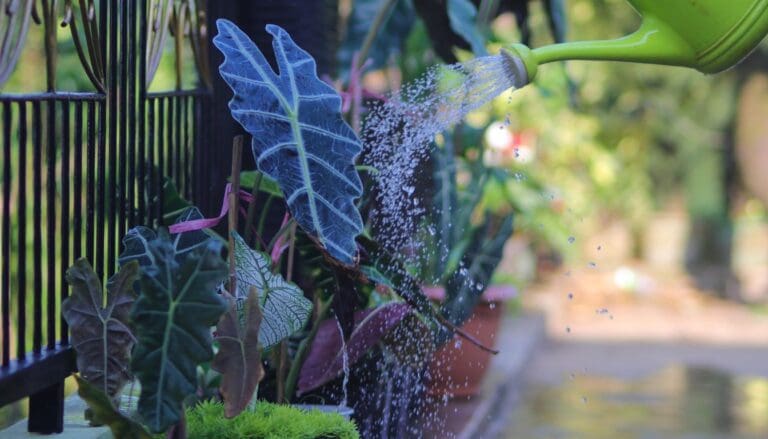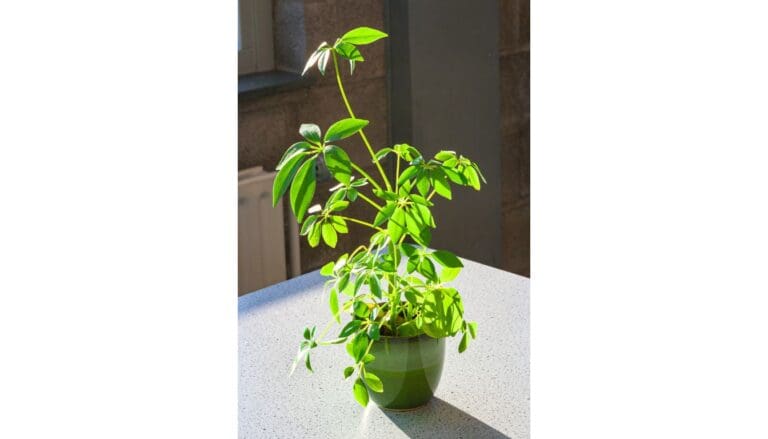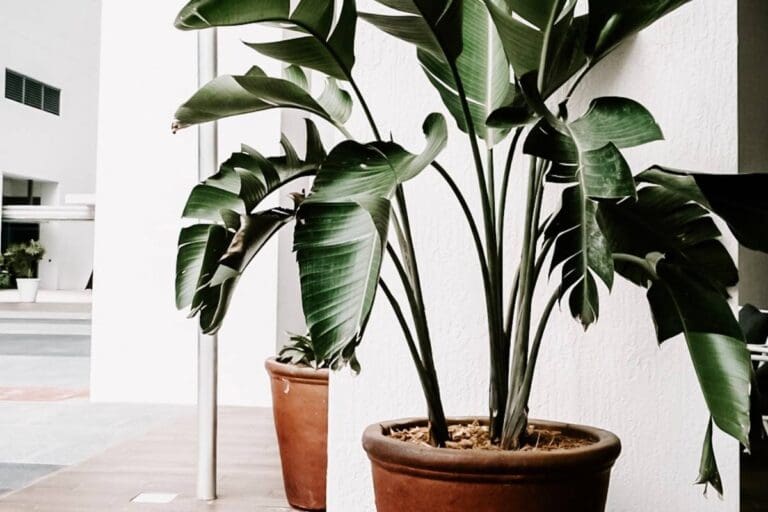How Fast Does Boston Fern Grow? (+Boston Growth Rate)
Boston fern is a houseplant popular for its beautiful sword-like foliage with tiny leaflets. They are also loved for their air-purifying properties. But, if you are wondering how fast Boston ferns grow, you are at the right place.
Boston fern is a slow-growing plant that can grow up to 4 feet as houseplants and 7 feet in the wild. They go dormant during the winter and start growing again during the spring and summer. Under ideal conditions, you can expect a growth of 8-10 inches every year with 10-12 new leaves.
Their growth slows down when Boston ferns hit the dormancy period. Factors like light, soil, temperature, pests, watering, etc., also affect their growth rate.
In this article, I will discuss how fast the Boston fern grows and the various factors that affect its growth. So, keep reading.

Please note: Simplify Plants is reader-supported. Some links in the post are affiliate links and I get a commission from purchases made through links in the post.
Are Boston Fern slow-growing plants?
Boston ferns are slow-growing plants.
They usually take 6 months up to a year to gain proper height and width.
Often, indoor gardeners seek plants that don’t grow rapidly and take significant time and care to mature.
Under these conditions, the Boston fern is an ideal houseplant.
However, there are few varieties of Boston fern which have different growth rates.
Some varieties grow faster than others, and some require more nurturing.
The season can greatly affect the growth rate, while other factors like fertilizers, humidity, soil, temperature, etc., also largely influence the growth of Boston Fern.
The average height of a Boston Fern grown indoors is 2-3 feet tall and 3 feet wide.
Factors that affect the growth of Boston Fern
Often, one can experience stunted growth or less growth in their houseplants, resulting from improper care and underlying issues.
However, Boston ferns are already slow-growing plants, and additional problems can even reduce their growth rate.
Some factors that affect the growth rate of Boston ferns are:
- Season
- Fertilizer
- Potting soil
- Light
- Temperature
- Watering
- Humidity
- Adaptability
- Pruning
- Pest
Keep reading to know more about these factors in detail.

Season
The most important factor that affects any indoor plant’s growth rate is the season.
There are two phases for any plant: the growing phase and dormancy.
During the growth phase, plants grow rapidly under favorable conditions like proper sunlight, temperature, humidity, etc.
While plants don’t receive ideal conditions to grow during dormancy, they conserve their energy and rest rather than wasting it on growing.
For Boston Ferns, spring and summer are the ideal growing seasons.
For planting them, consider the fall or spring seasons.
These are the seasons when they receive all the favorable conditions needed to grow.
Proper sunlight, warmth, and humidity accelerate their growth rate, so significant growth can occur during the growth phase.
During the dormancy, plants receive inadequate sunlight, warmth, humidity, and other growth factors.
So, they store the energy produced rather than utilizing it in growth.
You should take proper care of the plant and let it rest during dormancy.
Fertilizer

The next most important factor that affects growth is proper nutrients.
Fertilizers provide additional nutrients to the plant, which the soil often lacks.
If used for months, the soil becomes old and lacks nutrients.
If you use old soil to plant new houseplants, fertilization is necessary.
Boston ferns are not heavy feeders, so feeding them every two months during their growing phase is more than enough.
Although they are not heavy feeders, you might not see an increase in the growth rate unless proper fertilization is done.
They prefer water-soluble balanced fertilizers with 20:10:20 NPK.
Nitrogen is the leading component that accelerates plant growth.
But too much fertilizer can stop the plant from growing as it will damage the roots.
You should strictly avoid fertilizing Boston fern during winters as the plant remains dormant and doesn’t need additional nutrients during that phase.
Also read: Should I Fertilize My Boston Fern? (Ideal Fertilizer+When & How Much)
Potting Soil

Boston ferns can survive in organically rich, loamy soil with good drainage and a slightly acidic pH value.
Soil with poor drainage is a big no, and it can also cause root rot.
It prefers moist soil that is not too soggy, so you must get the right mix.
If you don’t choose the right soil, the soil will either drain out the water and nutrients too fast or remain soggy.
Both of these situations are not ideal for a plant’s growth.
These conditions will affect the growth rate negatively.
Use a potting mix to retain enough moisture to keep the soil moist and drain excess moisture to avoid making it soggy.
It should also hold nutrients needed for the growth of plants.
Boston fern prefers a mixture of soil, sand or perlite, and shredded sphagnum.
You can also add 1 part of dried cow manure and a pint of small gravel to increase efficiency.
Vermiculite increases the moisture-retaining capacity of the soil, so mixing it with potting will benefit moisture-loving indoor plants.
Also read: What Kind Of Soil For Boston Fern? (Ideal Soil Mix+How To Make)
Light

Light is another crucial factor that determines the growth of any plant.
Plants need proper sunlight for proper functioning and vital activities such as photosynthesis.
With the help of photosynthesis, plants generate food which provides the energy for growth.
Thus, plants exposed to proper light perform photosynthesis effectively and grow faster.
Rotate the houseplant at regular intervals to ensure that all sides receive equal light for even growth.
Boston fern needs indirect bright light like any typical houseplant.
They grow healthy and show bright colors when kept under bright yet indirect sunlight.
The ideal time to keep it outside is early morning, when the light intensity is low.
Keep your plant pot in such a position where it will receive bright indirect sunlight.
If the natural light available is insufficient for your plant, one can also use artificial light and keep the plant under it.
Artificial lights are easily available in the market.
Also read: What Kind Of Lighting Does A Boston Fern Need?
Adaptability
When you first bring a newly grown Boston fern from the nursery, it gets exposed to different conditions.
Plants need some time to get accustomed to their immediate surroundings.
The nursery may have different light, temperature, and humidity than your house.
When we first bring any small plant, sudden environmental change can stress the plant.
A stressed plant will never show signs of growth.
Let the plant rest and get used to its new surroundings.
Gradually, it will recover from the shock and start showing signs of active growth.
However, different species have different adaptability skills.
They have different requirements.
So, to understand your plant properly, inspect it during its initial days.
Temperature

Boston ferns can tolerate temperatures as warm as 95°F during the daytime, and during the night, 65°F is sufficient.
The ideal range for these plants is 60-75°F.
They can tolerate cold temperatures for a few hours, but it will negatively affect the growth rate.
They thrive best in warm places with humidity.
The temperature should be neither too hot nor too cold.
It will mature and grow if you provide warmth and humidity, similar to their native land.
But, if you reside in a cooler region, the growth rate can drop due to a lack of hot and humid weather.
The main reason plants experience dormancy during winters is that the temperature falls rapidly.
You must keep your plant away from dew, frost, snow, and low temperatures during winter.
Keep them inside or in a room with a fireplace to provide proper temperatures.
Keeping your Boston fern too close to a fireplace, heater, radiator, or any heat source where it will receive damaging heat can cause chemical burns.
These can dehydrate the plants, which will affect the growth rate and the health of the plant.
Therefore, do not expose your Boston fern to a cold and dry environment.
Watering

To have an actively growing Boston Fern, you must maintain proper watering methods.
Many houseplant owners make this mistake as it takes a while to understand the plant’s watering requirement, especially when starting.
Boston ferns need moist soil all the time but can’t withstand soggy soil.
While watering, ensure your water properly and check the soil’s moisture before watering to avoid overwatering.
Boston ferns require weekly watering.
The best way to know whether your plant needs water is to pick it up and check the weight.
If the pot is heavy, it doesn’t need water, and if it’s not heavy, it needs water.
The top layers of soil must dry out before watering.
You can also use a moisture meter to understand if the plant requires water.
Overwatering the plant can lead to yellow foliage and wilted weak stems, which may eventually lead to root rot and fungal diseases.
A damaged plant will never grow properly.
While too little water can also cause wilting, brown fronds, and other damages.
If the watering pattern is ignored, the growth rate will slow down and eventually stop.
Also read: How To Water Boston Fern? (How Often, How Much & More)
Pruning

Pruning is always recommended to encourage healthy growth among plants.
The removal of dried yellow leaves and damaged leaves help the plant to focus on overall growth rather than wasting its energy on damaged parts.
Pruning off unwanted plant debris helps the plant to grow.
You must never skip pruning sessions whenever needed, as it directly affects the plant’s growth.
Moreover, damaged yellow or brown leaves can also destroy the look of the plant.
Always prune during the active growing period because the plant will grow healthier and stronger with proper care.
You should always use a sharp pair of sterilized scissors or pruners.
Sterilization is important to avoid the spread of bacteria and fungal infections.
Pests

Pests are probably one of the biggest issues with indoor plants.
These tiny nasty bugs feed on the nutrients present in the leaves and kill them.
If not cured and taken care of immediately, pests will negatively affect the plant’s growth.
Most pests attack plants in groups and make them weaker day by day.
Pests feed on the nutrients that plants use for their growth and functioning.
A Boston fern that has been infected with pests will not grow at the rate it is supposed to, as it will lack the nutrients needed to grow.
Pests usually attack new leaves and hamper the growth of new foliage.
Keep the infected plant away from other indoor plants as pests can spread easily from one plant to the other.
Common pests that attack Boston ferns are caterpillars, mealybugs, thrips, scales, and spider mites.
There are many methods to eliminate pests:
- You can handpick the pests.
- Use a 15% rubbing alcohol and 85% water solution and wipe the affected areas with it.
- Use horticulture oils.
- You can also spray a solution of Neem soil, mild dishwashing gel in water, and spray it on the infected area regularly.
- If nothing works, you can go for organic pesticides widely available in the market.
You can spray a Neem oil solution on the plant to prevent the pests.
Humidity

Boston ferns thrive their best in a humid environment.
This is also one of the most important factors that affect their growth.
Tropical houseplants typically need high humidity levels, as it accelerates the growth rate of these plants.
A plant’s main issue if it doesn’t receive adequate humidity is a reduced growth rate.
Boston fern will not die in low humidity, but it will deteriorate the plant’s health.
Boston plants prefer humidity levels above 80%!
Even if you can’t provide as much humidity, you must not let it drop below 50-70%.
- To raise the humidity in the surrounding environment of your Boston fern, get a humidifier.
- A pebble tray can also help if you don’t have a humidifier.
- You can keep your Boston fern near other humidity-loving plants.
- You can relocate the Boston fern to the bathroom, kitchen, or basement to increase the humidity levels around it.
- You can keep it near an aquarium if you have one.
- Don’t expose your plant to dry weather conditions.
Also read: Should I Mist My Boston Fern? (How Often+Pros & Cons)
How can I make my Boston Fern grow faster?
It is natural to wish to see your Boston fern growing faster and healthier.
I have mentioned tips and ways to make your Boston fern grow faster.
| Factor | Tips |
|---|---|
| Light | Keep the pot of your Boston fern under bright indirect sunlight, as low lights will not promote healthy growth. Use artificial light if it doesn’t get enough light for faster growth. |
| Watering | Maintain a proper watering pattern to keep the soil moist. Check the soil’s moisture content with a moisture meter before watering it to avoid overwatering or underwatering. |
| Humidity | If the environment is too dry for the Boston fern, use a humidifier to increase humidity, or you can also mist around the plant. Grouping humidity-loving plants together is also an effective way to increase humidity. |
| Temperature | The temperature around the plant should not fluctuate. It should have a constant warm condition. |
| Pruning | Prune it to get rid of dead and damaged leaves. This will help the plant to invest its energy in new growth. |
| Fertilization | During spring and summer, provide a balanced liquid fertilizer with an NPK of 20:10:20 to provide additional nutrients. Fertilizers rich in nitrogen can promote growth. |
| Dormancy | Don’t expect plants to grow actively during winters as they hit dormancy. Let them rest. |
Reference: University of Florida, The University of Arkansas Division, Texas A&M University System, The University of Georgia, University of New Hampshire, Wikipedia, The Royal Horticultural Society.
Recommended Garden Supplies
| Product Image | Our Recommended Gardening Supplies | Check Offers! |
|---|---|---|
Top Top
Top
Top
Top
Top
Top
Top
Top | rePotme Houseplant and Tropical Classic Potting Soil Mix | Check Offer On Amazon |
 Top
Top
Top
Top
Top
Top
Top
Top | Espoma Organic Indoor Plant Food | Check Offer On Amazon |
 Top
Top
Top
Top
Top
Top
Top
Top | GooingTop LED Grow Light 6000K Full Spectrum Clip Plant Growing Lamp | Check Offer On Amazon |
 Top
Top
Top
Top
Top
Top
Top
Top | Soil Moisture Meter | Check Offer On Amazon |
 Top
Top
Top
Top
Top
Top
Top
Top | Govee Hygrometer Thermometer, Bluetooth Enabled! | Check Offer On Amazon |
 Top
Top | LEVOIT Humidifiers for Large Room(Best For Plants) | Check Offer On Amazon |
 Top
Top
Top
Top
Top
Top
Top
Top | Upgraded DIY Automatic Drip Irrigation Kit, 15 Potted Houseplants Support | Check Offer On Amazon |
 Top
Top
Top
Top
Top
Top
Top
Top | Stainless Steel Heavy Duty Gardening Tool Set | Check Offer On Amazon |
 Top
Top
Top
Top
Top
Top
Top
Top | Bonide Insecticidal Soap | Check Offer On Amazon |
 Top
Top
Top
Top
Top
Top
Top
Top | Bonide 32 oz Spray Neem Oil for Organic Gardening | Check Offer On Amazon |
 Top
Top
Top
Top
Top
Top
Top
Top | Garden Safe Fungicide | Check Offer On Amazon |






